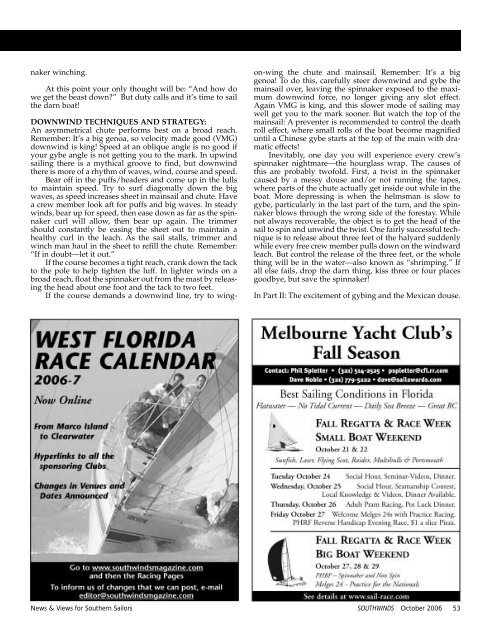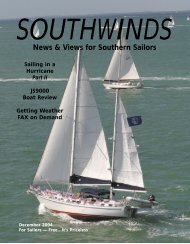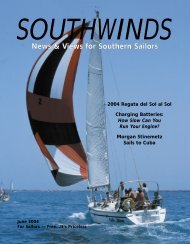News & Views for Southern Sailors - Southwinds Magazine
News & Views for Southern Sailors - Southwinds Magazine
News & Views for Southern Sailors - Southwinds Magazine
- No tags were found...
You also want an ePaper? Increase the reach of your titles
YUMPU automatically turns print PDFs into web optimized ePapers that Google loves.
naker winching.At this point your only thought will be: “And how dowe get the beast down?” But duty calls and it’s time to sailthe darn boat!DOWNWIND TECHNIQUES AND STRATEGY:An asymmetrical chute per<strong>for</strong>ms best on a broad reach.Remember: It’s a big genoa, so velocity made good (VMG)downwind is king! Speed at an oblique angle is no good ifyour gybe angle is not getting you to the mark. In upwindsailing there is a mythical groove to find, but downwindthere is more of a rhythm of waves, wind, course and speed.Bear off in the puffs/headers and come up in the lullsto maintain speed. Try to surf diagonally down the bigwaves, as speed increases sheet in mainsail and chute. Havea crew member look aft <strong>for</strong> puffs and big waves. In steadywinds, bear up <strong>for</strong> speed, then ease down as far as the spinnakercurl will allow, then bear up again. The trimmershould constantly be easing the sheet out to maintain ahealthy curl in the leach. As the sail stalls, trimmer andwinch man haul in the sheet to refill the chute. Remember:“If in doubt—let it out.”If the course becomes a tight reach, crank down the tackto the pole to help tighten the luff. In lighter winds on abroad reach, float the spinnaker out from the mast by releasingthe head about one foot and the tack to two feet.If the course demands a downwind line, try to wingon-wingthe chute and mainsail. Remember: It’s a biggenoa! To do this, carefully steer downwind and gybe themainsail over, leaving the spinnaker exposed to the maximumdownwind <strong>for</strong>ce, no longer giving any slot effect.Again VMG is king, and this slower mode of sailing maywell get you to the mark sooner. But watch the top of themainsail: A preventer is recommended to control the deathroll effect, where small rolls of the boat become magnifieduntil a Chinese gybe starts at the top of the main with dramaticeffects!Inevitably, one day you will experience every crew’sspinnaker nightmare—the hourglass wrap. The causes ofthis are probably twofold. First, a twist in the spinnakercaused by a messy douse and/or not running the tapes,where parts of the chute actually get inside out while in theboat. More depressing is when the helmsman is slow togybe, particularly in the last part of the turn, and the spinnakerblows through the wrong side of the <strong>for</strong>estay. Whilenot always recoverable, the object is to get the head of thesail to spin and unwind the twist. One fairly successful techniqueis to release about three feet of the halyard suddenlywhile every free crew member pulls down on the windwardleach. But control the release of the three feet, or the wholething will be in the water—also known as “shrimping.” Ifall else fails, drop the darn thing, kiss three or four placesgoodbye, but save the spinnaker!In Part II: The excitement of gybing and the Mexican douse.<strong>News</strong> & <strong>Views</strong> <strong>for</strong> <strong>Southern</strong> <strong>Sailors</strong> SOUTHWINDS October 2006 53
















